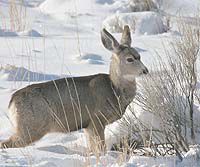| Animals on winter range can be susceptible to many kinds of disturbances. Sometimes even a nominal disruption can cause death for some. |
Dogs chasing deer and people chasing deer antlers: just two forms of wildlife harassment that can stress, injure and kill wildlife
Pronghorn antelope are normally fleet of foot, and they can usually run fast across sagebrush flats and hills. But when heavy snows come fast and furious to Utah’s high deserts, pronghorns tend to slow down and huddle together. This slowing down and huddling together allows the pronghorns to conserve their energy. It’s also a reminder that wildlife often have to change their behavior to survive the harsh realities of winter.
Gathering together, or herding, is a survival adaptation that deer, antelope and even elk utilize during the winter. Biologists believe that big game animals form these masses of bodies to take advantage of each other’s body heat. Their fur is hollow, and huddling together provides extra insulation. Every ounce of heat the animals conserve is energy they need to make it through the winter. These adaptations have served them well for thousands of years.
But within the past few decades, some additional challenges have arisen that the animals haven’t had to face before.These extra challenges cause concern for wildlife biologists every year. These challenges come mostly in the form of people or their pets getting too close to big game animals. Whether intentional or accidental, this “harassment” has the same damaging effect.
Some of these occurrences may seem harmless at first. For example, a cross-country skier may surprise and startle a herd, and the herd runs over a hill. That’s the end of the story for the skier, who was thrilled to see these beautiful animals. But for many of the animals in the herd, that surprise visit may be the determining factor that causes some of them to die.
The Division of Wildlife Resources has successfully acquired thousands of acres of rangelands that are critical to big game animals in the winter. Called wildlife management areas (WMAs), these areas have been painstakingly managed to provide food, water, shelter and space for wildlife. Outdoor recreationists are reminded that these winter range properties are closed to access until after the animals have migrated to their summer ranges.

